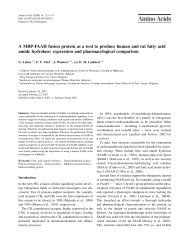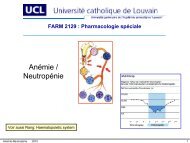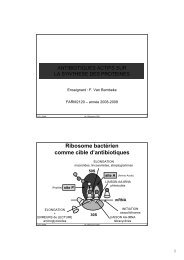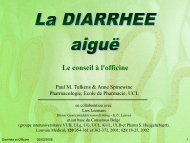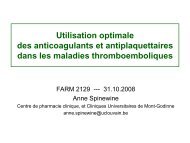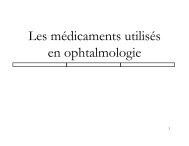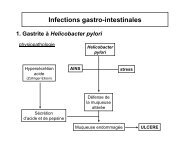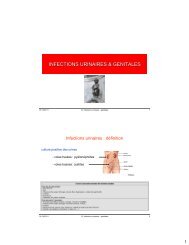Fn-type Chicory Inulin Hydrolysate Has a Prebiotic Effect in Humans
Fn-type Chicory Inulin Hydrolysate Has a Prebiotic Effect in Humans
Fn-type Chicory Inulin Hydrolysate Has a Prebiotic Effect in Humans
You also want an ePaper? Increase the reach of your titles
YUMPU automatically turns print PDFs into web optimized ePapers that Google loves.
1198<br />
food consumed by the volunteers dur<strong>in</strong>g the day, <strong>in</strong> such quantities as<br />
to provide a total daily <strong>in</strong>take of8gofchicory oligofructose, of which<br />
90% (7.2 g) was pure <strong>Fn</strong>-<strong>type</strong>.<br />
Feed<strong>in</strong>g a controlled diet dur<strong>in</strong>g periods 1 and 2 was <strong>in</strong>tended to<br />
m<strong>in</strong>imize the <strong>in</strong>ter<strong>in</strong>dividual variations <strong>in</strong> food <strong>in</strong>takes that could<br />
have <strong>in</strong>fluenced the composition of the fecal microflora <strong>in</strong>dependent<br />
of oligofructose <strong>in</strong>take.<br />
Dur<strong>in</strong>g these two periods, the volunteers were required to visit a<br />
central restaurant, where they had access to a buffet (breakfast and<br />
lunch) and were given a vacuum-sealed d<strong>in</strong>ner to consume at home.<br />
These meals were prepared so as to m<strong>in</strong>imize the consumption of<br />
naturally oligofructose/<strong>in</strong>ul<strong>in</strong>-rich products (Van Loo et al. 1995) like<br />
onions, leeks, bananas, artichokes and wheat, as well as yogurts and<br />
fermented milk products. Dur<strong>in</strong>g these two periods, the foods given to<br />
the volunteers were very similar, except for the <strong>in</strong>take of chicory<br />
oligofructose (8 g/d) dur<strong>in</strong>g period 2. Dur<strong>in</strong>g period 3, the volunteers<br />
were asked to consume their usual home-cooked meals but still<br />
exclud<strong>in</strong>g oligofructose/<strong>in</strong>ul<strong>in</strong>-rich food products and fermented dairy<br />
products.<br />
As <strong>in</strong> other studies on the bifidogenic effect of fructans (Budd<strong>in</strong>gton<br />
et al. 1996, Gibson et al. 1995, Kleessen et al. 1997, Williams et<br />
al. 1994), each volunteer acted as his/her own control and no separate<br />
placebo group was <strong>in</strong>cluded. Us<strong>in</strong>g such a protocol avoids a<br />
cross-over design <strong>in</strong> which the length of the wash-out <strong>in</strong>terval is often<br />
difficult to evaluate precisely.<br />
Sample collection. Fresh stools were collected: sample 1 (last day<br />
of wk 2) at the end of the control period; sample 2 (last day of wk 4)<br />
at the end of the treatment 1 period; and sample 3 (last day of wk 7)<br />
at the end of the treatment 2 period.<br />
Dur<strong>in</strong>g both the control and treatment 1 periods, the volunteers<br />
were requested to complete a daily well-be<strong>in</strong>g questionnaire, provid<strong>in</strong>g<br />
<strong>in</strong>formation about possible digestive discomfort (cramps, bloat<strong>in</strong>g,<br />
flatulence, soft stools or diarrhea) as well as frequency and appearance<br />
of stools.<br />
Protocol for bacteriological analyses (Beerens 1991, Gibson et<br />
al. 1995). All stool samples (m<strong>in</strong>imum weight 20 g) were processed<br />
anaerobically (desk-<strong>type</strong> home-made anaerobic glove-box conta<strong>in</strong><strong>in</strong>g<br />
an atmosphere of H 2,CO 2 and N 2, 10:10:80) with<strong>in</strong> 60 m<strong>in</strong> after<br />
defecation. Samples were weighed and then homogenized <strong>in</strong> 0.1<br />
mol/L (pH 7) phosphate buffer to obta<strong>in</strong> a 100 g/L fecal suspension.<br />
Serial dilutions were prepared us<strong>in</strong>g half-strength Peptone water<br />
(Oxoid), the samples (0.1 mL) were <strong>in</strong>oculated onto agar medium<br />
specific for the growth of total anaerobes (Wilk<strong>in</strong>s-Chalgren anaerobic<br />
agar), bifidobacteria (Clostridia agar supplemented with 0.0125<br />
g/L iodoacetic acid, 0.02 g/L nalidixic acid, 0.05 g/L kanamyc<strong>in</strong>,<br />
0.009 g/L polymyx<strong>in</strong>, 0.025 g/L triphenyltetrazolium chloride), lactobacilli<br />
(Rogosa), coliforms (MacConkey #3), bacteroides (BMS<br />
supplemented with 5 g/L glucose, 0.5 g/L ammonium sulfate, 0.01g/L<br />
nalidixic acid and 0.003 g/L vancomyc<strong>in</strong>) and Clostridium perfr<strong>in</strong>gens<br />
(Tryptose Sulfite Cycloser<strong>in</strong>e Agar Base or TSC supplemented with<br />
fluorcult).<br />
Anaerobic <strong>in</strong>cubations (<strong>in</strong> duplicate) for colony development<br />
took place <strong>in</strong> anaerobic jars conta<strong>in</strong><strong>in</strong>g Anaerocult A (Merck). For<br />
each fecal sample, a count was made of viable colony-form<strong>in</strong>g units<br />
(cfu) of total anaerobes after <strong>in</strong>cubation at 37°C for 4 d, bifidobacteria<br />
(4 d), bacteroides (4 d), lactobacilli (3 d), coliforms (1 d) and<br />
clostridia (1 d). After <strong>in</strong>cubation, <strong>in</strong>dividual colonies were removed<br />
from the plates and subcultured <strong>in</strong>to peptone/yeast/glucose broth.<br />
Bacteria were characterized to genus level on the basis of colony<br />
appearance, Gram’s reaction and cell morphology. Presumptive culture<br />
identities were confirmed through colony morpho<strong>type</strong>, microscopic<br />
characteristics and limited biochemical tests (Gibson et al.<br />
1995).<br />
Statistical analysis. The nonparametric Friedman test was used<br />
after logarithmic transformation of the data. This test, made by order<br />
of rank (rank averages) was chosen because it permits comparison of<br />
several mean values of non<strong>in</strong>dependent observations, which is the<br />
case <strong>in</strong> this study, where comparable samples were all taken from the<br />
same volunteers but dur<strong>in</strong>g different feed<strong>in</strong>g periods. Results were<br />
statistically analyzed on the basis of: i) a global comparison of mean<br />
values to identify differences between the three feed<strong>in</strong>g periods and<br />
MENNE ET AL.<br />
TABLE 1<br />
<strong>Effect</strong> of feed<strong>in</strong>g 8 g/day chicory oligofructose (of which 7.2 g<br />
was <strong>Fn</strong>-<strong>type</strong> molecules) on the logarithm (log10) ofthe<br />
number of the colony-form<strong>in</strong>g units (cfu) of major bacteria <strong>in</strong><br />
fresh fecal samples of male and female volunteers fed either a<br />
controlled (treatment 1) or a home cooked-diet (treatment 2)1<br />
Bacteria<br />
Tim<strong>in</strong>g of microbiological analyses<br />
Before treatment After 2 weeks After 5 weeks<br />
Control value Treatment 1 Treatment 2<br />
Total anaerobes 10.3 0.6 10.1 0.5 10.4 0.4<br />
Bifidobacteria 8.6 0.5 9.6 0.3* 9.4 0.6*<br />
Lactobacilli 5.7 1.0 6.0 1.5 6.4 0.7<br />
Bacteroides 8.9 0.2 8.8 0.2 9.2 0.7<br />
Coliforms 7.0 1.3 6.6 1.6 6.5 1.2<br />
C. perfr<strong>in</strong>gens 3.5 1.2 3.2 1.0 3.2 0.8<br />
1 Values are means SD, n 8.<br />
* Significantly different from before treatment.<br />
ii) paired comparisons to search for differences between periods. The<br />
significance threshold was set at 5% (P 0.05).<br />
RESULTS AND DISCUSSION<br />
The key criterion for a prebiotic effect is the demonstration<br />
of the selective stimulation of growth of one particular, or a<br />
limited number of, potentially beneficial bacteria <strong>in</strong> the complex<br />
fecal microbiota follow<strong>in</strong>g the consumption of a particular<br />
food. Data should demonstrate that the number (e.g.,<br />
expressed as log 10 cfu/g of feces) of bacteria <strong>in</strong> that particular<br />
population <strong>in</strong>creased significantly, while the others did not<br />
change or even decreased (Gibson and Roberfroid 1995, Gibson<br />
et al. 1999, Roberfroid et al. 1998).<br />
Table 1 reports the values of the total numbers of cfu<br />
(expressed as log 10 cfu/g of feces) for the various bacteria<br />
analyzed <strong>in</strong> the feces of the eight volunteers fed a diet with and<br />
without chicory oligofructose. A global analysis of the different<br />
values reveals that the daily <strong>in</strong>take of 8gofoligosaccharides<br />
did not significantly (P 0.05) modify the counts of<br />
total anaerobes, lactobacilli, bacteroides, coliforms or C. perfr<strong>in</strong>gens,<br />
but it did significantly (P 0.01) <strong>in</strong>crease the counts<br />
of bifidobacteria.<br />
The paired comparisons reveal that: i) at the end of the<br />
treatment 1 period, after eat<strong>in</strong>g a control diet supplemented<br />
with 8 g/d chicory oligofructose (of which 7.2 g was <strong>Fn</strong>-<strong>type</strong><br />
molecules) for 2 wk, the number of bifidobacteria <strong>in</strong> feces had<br />
<strong>in</strong>creased significantly (P 0.01) compared to the end of the<br />
control period; ii) at the end of the treatment 2 period, after<br />
eat<strong>in</strong>g the usual home-cooked diet supplemented with 8 g/d<br />
chicory oligofructose (of which 7.2 g was <strong>Fn</strong>-<strong>type</strong> molecules)<br />
for an additional period of 3 wk, the number of bifidobacteria<br />
<strong>in</strong> feces were still significantly (P 0.01) higher than at the<br />
end of the control period but not significantly different from<br />
the counts at the end of the treatment 1 period.<br />
These data thus demonstrate that, as is the case with<br />
G<strong>Fn</strong>-<strong>type</strong> oligofructose (Gibson et al. 1995, Roberfroid et al.<br />
1998, Van Loo et al. 1999), a preparation of chicory oligofructose<br />
conta<strong>in</strong><strong>in</strong>g 90% of <strong>Fn</strong>-<strong>type</strong> molecules selectively stimulates<br />
the growth of colonic bifidobacteria <strong>in</strong> human volunteers,<br />
as evidenced by the <strong>in</strong>crease <strong>in</strong> fecal number.<br />
Furthermore, the data demonstrate the selectivity of that



